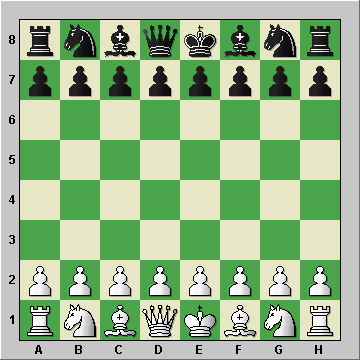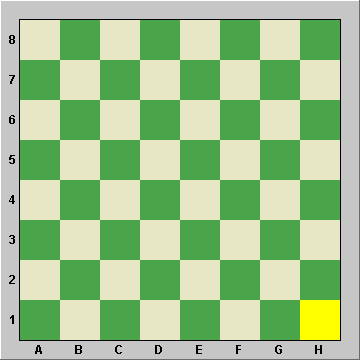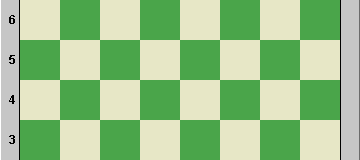
Before you start to play a game of chess, you obviously have to setup the board and pieces, and they have to be setup the same way every time. Here is the correct way to set up the board and pieces for play:

"Gee, Mr. Chessguy, that's looks awfully complicated!", you might say. Well, its really not. Let's see if we can break it down into some individual steps (and a couple of simple rules) that will make it really easy.
 First lets look at the board by itself.
First lets look at the board by itself.
The board is 8 squares by 8 squares, for a total of 64 squares. There IS a right way and a wrong way to set up the board. The rule to remember here is that a light-colored square MUST go in your right hand corner, as highlighted in yellow. Believe me, it DOES make a difference, as we'll soon see.
(By the way, some boards come with letters and numbers along the outside edges, as I'm showing here. That has to do with something called 'chess notation', which we'll get into later down the road. But if your board has these letters and numbers, you position it so that the letters face the players and the numbers are along the right-hand and left-hand sides. If you do that, then your right-hand corner square will be light-colored, guaranteed!)
Next, we'll get about half the job finished by setting up the pawns. There're 8 white pawns and 8 black pawns. They're simple. You just line them up on the second and seventh rows. (8 squares, 8 pawns. Simple.)
|
See, I told you this was simple. You're already half way done. (Also, notice the letters along the side of the board, if you've got that kind of board. We placed the white pawns on the row with the '2', and the black pawns on the '7' row. Again, that'll become more important later on when we look at 'chess notation'. By the way, 'rows' are sometimes called 'ranks', as in the 2nd rank and the 7th rank.)
|
|
Now lets handle the rooks. There are four of them, two white rooks and two black rooks, and they go into the four corners. Guess which colors go where....
|
|
What, you didn't think Black rooks were set up behind the white pawns, did you? That would end games real quick!. |
Anyway, now we'll look at knights. There are four of them, as well (two white and two black) and they get placed next to the rooks.
| There're the knights.... |
|
The bag of pieces is getting pretty empty, isn't it? Okay, now we'll place the bishops. Based on where the knights went, anyone care to guess where bishops go?
|
|
That's right. Bishops get set up next to the knights. |
Now we're down to kings and queens and now lets go back to review when we first unrolled the board and put it on the table. Remember I said the board had to be placed so that square on your right-hand side was light, and not dark? Now you'll see why, as we place the queens on the board.
The simple rule to remember here is 'queens are set up on their own color squares'. By that, I mean the white queen starts on a white square and the black queen starts on a black square. So since we've been grouping the pieces together by color, where do you think the white queen would go so that it sits on its own color?
| Exactly. The white queens starts on a white square. |
|
And the black queen? Think about it now.... Black queen on a black square.....
|
|
Yep, that's it! Queens go on their own color squares. |
Now let's see, all we got left is a couple of kings. Anyone have any ideas?..... Come on, now......



Guess what? You've set up the board and pieces. You're ready to play! Practice this a few times, and it'll become second nature to you. You'll be able to lay out a chess set without even thinking about it. And I'll let you in on a little secret: just having gone through this exercise, you now know more about chess than 75% of everyone else, everywhere!
(I'll also make you a bet that if you watch people playing chess in a movie or on TV, many more times than not they'll have the pieces set up wrong and don't even know it!)
Yeah, there're hoards of people out there who don't even know how to set up a chess set correctly.
|
|
YOU know how, though, and that makes you pretty special! |
 |